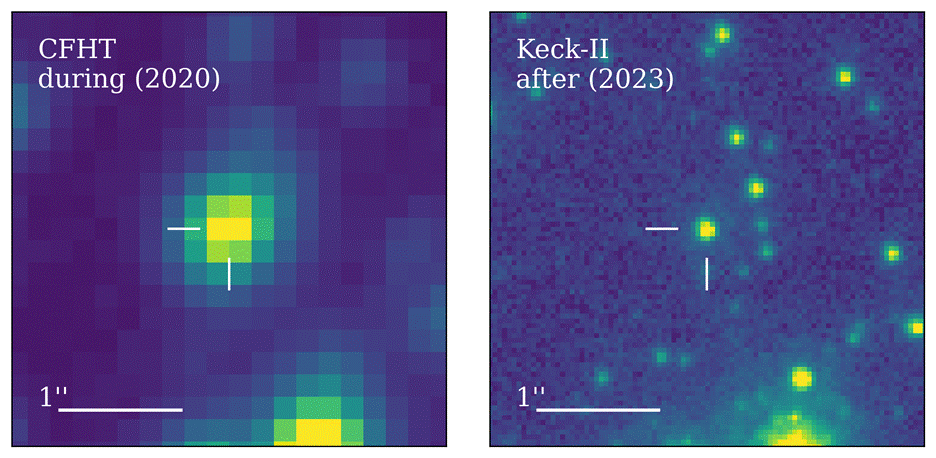
Images of the area of the microlensing event, indicated by perpendicular white lines two weeks after peak magnification of the background star in 2020, taken by CFHT with seeing of ~ 0.5 arcsec (Left) and in 2023 after its disappearance, obtained by Keck-II with seeing of ~0.08 arcsec (Right). The planetary system with a white dwarf, a two-Earth-mass planet and brown dwarf cannot be seen; the point of light in (Right) is from the background source star that is no longer magnified.
Stars like the Sun eventually inflate, like a balloon, becoming as large as Earth’s present orbit, engulfing Mercury and Venus in the process. As the star expands to become a red giant, its decreasing mass moves planets to more distant orbits, offering a slim opportunity for Earth to avoid plummeting into the Sun. Eventually, the outer layers of the red giant are blown away to leave behind a dense white dwarf in size no larger than a planet but of stellar mass. The paper, published this week, shows the discovery of a planetary system 4,000 light years away, which consists of a white dwarf about half the mass of the sun, a two-Earth-mass planet and a brown dwarf near the brown dwarf/planet boundary. They are orbiting the white dwarf at a distance twice and 20 times as large as Earth's orbit today, respectively.
In July 2020, a distant star near the Galactic center drew the attention of Weicheng Zang, a former doctoral student and a Special Prize winner of the Department of Astronomy (DoA) at Tsinghua University and presently a CfA Fellow at the Center for Astrophysics|Harvard & Smithsonian. Its light was magnified by a factor of a thousand, because of the gravitational microlensing effect, by which the gravity of the foreground system acts like a lens to focus and amplify the light from the background star. The event was first discovered by the Korea Microlensing Telescope Network (KMTNet), of which Dr. Zang was a former member. Then, he conducted follow-up observations using LCOGT and CFHT telescope time awarded through the Telescope Access Program (TAP) and also acquired data from the KMTNet, MOA, and MicroFUN groups. The analysis, published in a paper in 2021, revealed two companions around the foreground star, but it was unclear what type of star the host belonged to, because its light was lost in the glare of the magnified background star and several nearby stars.
To identify the type of star, Keming Zhang (Eric and Wendy Schmidt AI in Science Postdoctoral fellow at UC San Diego at UC San Diego) and Weicheng Zang proposed to look more closely at the light from the event using the Keck II 10-meter telescope in Hawaii, outfitted with adaptive optics to eliminate the blurring from the Earth’s atmosphere. A team led by Dr. Keming Zhang then conducted the Keck observations and ruled out the alternative scenario where the main lens is a normal star, in which case, it would have been easily seen. Because the lens is both dark and of low mass, the team concluded that it can only be a white dwarf that emits little light. While five known confirmed giant planets have been found orbiting white dwarfs, the two-Earth-mass planet is the first terrestrial planet discovered around a white dwarf. This discovery offers valuable insights into the possible survival of our own planet Earth in the distant future.
The new work was published in the journal Nature Astronomy. Keming Zhang is the first and corresponding author and Weicheng Zang is the second and corresponding author. Other co-authors include Prof. Shude Mao at Tsinghua University and astronomers from UC Berkeley, California Institute of Technology, University of Washington in Seattle, Ohio State University, UC San Diego, and University of Maryland in College Park.
The work of the Tsinghua team was supported by the Natural Science Foundation of China.
Paper Link:
1. https://www.nature.com/articles/s41550-024-02375-9
2. https://iopscience.iop.org/article/10.1088/1674-4527/21/9/239


